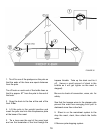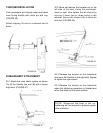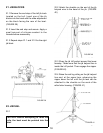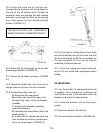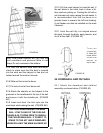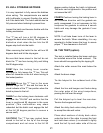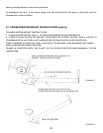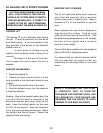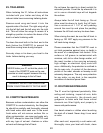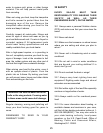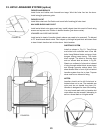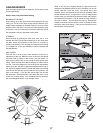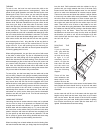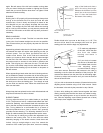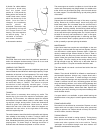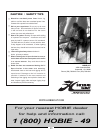
30
6) Hobie Cat rudder blades
are preset to break away
from the locked down
position at 17-26 pounds by
testing with a line around the
rudder blade seven inches
above the lowest tip of the
blade. Once the rake is
changed, the breakaway
tension should be
rechecked. The tension may
be adjusted by turning the
3/4" internal screw in the
housing. The screw tensions
an internal spring. Turn it
clockwise to increase
and counter clockwise
to decrease the tension.
TRAILERING
CAUTION: Boat and mast should be securely attached to
trailer with adequate tie-down straps. Failure to do so could
cause extensive damage or serious injury!
LOADING YOUR TRAILER
The weight of the boat, equipment and additional gear should
never exceed the manufacturer's rated weight capacity. Proper
distribution of the load is of vital importance. Too much weight
on the hitch will cause "tail dragging" of the towing vehicle,
impairing steering and raising headlights into the eyes of
oncoming traffic. Too little or negative weight on the hitch, and
the trailer will sway or "fishtail". The solution to proper
distribution is often adjusting movable gear. A more
permanent solution is to shift the axle position before taking
your boat to water the very first time.
TOWING
Extra caution is necessary when towing any trailer. The
heavier the rig, the more time required to accelerate, pass,
and stop. For this reason, the maximum speed for vehicles
with trailers is less than without a trailer in most states. A long
rig requires a larger turning radius. Curbs and obstructions
should be given wide clearance. Most boats on trailers
obstruct the rear view of the driver. When this happens, an
additional rear view mirror on the right side of the towing
vehicle is required by law.
The trailer boatman should be familiar with traffic and highway
laws relating to the towing of trailers. Towing a Hobie has
particular hazards that should be mentioned. A Hobie is very
wide. Obstacles should be given plenty of room when you are
passing them. Tie down straps or lashings should be of
sufficient size and diameter and placed on all four corners.
The mast support on a trailer is subject to a lot of side-to-side
motion and consequently may fatigue where it is welded to the
trailer. All this can be reduced by tying a line from each bow to
the mast support. This will stiffen the rig up and prolong the life
of the trailer.
LAUNCHING AND RETRIEVING
Prepare boat for launching at the top of the ramp or parking
facility. Remove all tie-down straps, check boat plugs and
fasten boat painter. Do not release winch line until the boat is
in the water. Back trailer to the left if possible; backing left
gives better launching visibility. Avoid dunking wheel bearings
wherever possible. Never leave the towing vehicle unattended
on the ramp with only the parking brake set. If vehicle must be
left while on the ramp, set transmission in "park" or first gear,
in addition to setting the parking brake. In retrieving your boat,
make sure that the boat is properly placed on the trailer. Pull
trailer up steadily to prevent spinning the wheels.
MAINTENANCE
Lights: Most state laws require two red taillights on the rear
that may be combined with the stop and turn signals. Vehicles
over 80 inches in width require clearance lights. If lights are
dunked, waterproof light fixtures should be used. If water is
allowed to enter, the lamp may crack and short out the entire
system. Water also promotes contact corrosion. Always carry
spare lamps. The wire coupling to the towing vehicle should
be high enough to stay dry. Never rely on the trailer hitch for
ground connection. Four-pole connectors should be used.
The mast should not extend over three feet behind the rear
light assembly.
Wheels: Tires should ALWAYS be inflated to manufacturer's
recommended pressure. Always carry a spare wheel and a
jack that fit the boat trailer. If wheel bearings are always
dunked, waterproof bearings and caps should be considered.
If water is allowed into the hub, lubricating grease will float
away and bearings will burn out or seize, causing damage and
a safety hazard. Waterproofed bearings should be inspected
prior to each boating season, others more often. Special care
should be given when traveling on unimproved roadways with
small diameter wheels.
If a spare wheel is not available, a spare wheel bearing set
should be taken on long trips in case the grease seal has been
broken.
FRAME AND ROLLERS
Rust should not be allowed to accumulate. Remove rust and
repaint with anti-rust paint. Some trailers offer galvanized
coating to prevent rust. Rollers should roll freely and should
not have checks, breaks or flat spots.
TOWING VEHICLE
Most vehicles are limited in towing capacity. Towing heavy
loads places extra demands on the engine, transmission,
brakes and other systems vital to the vehicle. Towing
"packages" are available through most auto dealers and
should be considered for heavy boats.



